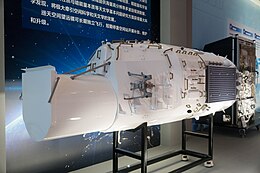 Xuntian mockup, showing its 2-meter diameter telescope | |||||||||||||
| Mission type | Astronomy | ||||||||||||
|---|---|---|---|---|---|---|---|---|---|---|---|---|---|
| Operator | CNSA | ||||||||||||
| Mission duration | 10+ years (planned) | ||||||||||||
| Spacecraft properties | |||||||||||||
| Dry mass | 15,500 kilograms (34,200 lb)[1] | ||||||||||||
| Start of mission | |||||||||||||
| Launch date | 2026[2] (planned) | ||||||||||||
| Rocket | Long March 5B | ||||||||||||
| Launch site | Wenchang Satellite Launch Center | ||||||||||||
| Contractor | CASC | ||||||||||||
| Orbital parameters | |||||||||||||
| Reference system | Low Earth orbit | ||||||||||||
| Main telescope | |||||||||||||
| Diameter | 2 metres (6.6 ft) | ||||||||||||
| Focal length | 28 m (92 ft) | ||||||||||||
| Wavelengths | 255 ~ 1000 nm (Survey camera), 0.41~0.51 THz (590~730 μm) (Terahertz receiver) | ||||||||||||
| Resolution | 0.15 arcsec | ||||||||||||
| |||||||||||||
Xuntian (Chinese: 巡天; pinyin: Xúntiān; lit: Tour of Heaven),[a] also known as the Chinese Space Station Telescope[5] (CSST) (Chinese: 巡天空间望远镜; pinyin: Xúntiān Kōngjiān Wàngyuǎnjìng) is a planned Chinese space telescope currently under development.[6]
It will feature a 2-meter (6.6 foot) diameter primary mirror and is expected to have a field of view 300–350 times larger than the Hubble Space Telescope.[7] This will allow the telescope to image up to 40 percent of the sky using its 2.5 gigapixel camera.

As of 2024, Xuntian is scheduled for launch no earlier than late 2026[2][8][9] on a Long March 5B rocket to co-orbit with the Tiangong space station in slightly different orbital phases, which will allow for periodic docking with the station.[10]
This state-of-the-art telescope, characterized by its off-axis design without any obstruction, sidesteps diffraction challenges associated with mirror support structures. As a result, its point spread function (PSF) remains unscathed, presenting a valuable asset for weak-lensing shear measurements.

The primary mission of the CSST revolves around high-resolution large-area multiband imaging and slitless spectroscopy surveys, spanning the wavelength range of 255–1,000 nm. Precise cosmology serves as the principal scientific driver behind this ambitious endeavor, with a focus on observing regions at median-to-high Galactic and ecliptic latitudes. Over a period of 10 years, the survey camera is slated to cover approximately 17,500 square degrees of the sky in various bands, reaching point-source 5σ limiting magnitudes of about 26 (AB mag) in g and r bands.
The CSST's spectral resolution (R=λ/Δλ) for the slitless spectrograph averages no less than 200, attaining wide-band-equivalent limiting magnitudes in GV (400–620 nm) and GI (620–1,000 nm) bands at about 23 mag. Beyond its wide-area survey, the CSST will target specific deep fields, aiming for observations that surpass the depth of the broader survey by at least one magnitude. The collective strengths of its angular resolution, depth, wavelength range, and capacity for both imaging and spectroscopy, coupled with extensive sky coverage, render the CSST survey highly competitive.
Notably, the CSST's observations are poised to complement and enhance other contemporaneous large-scale projects, including the Vera C. Rubin Observatory, the Euclid Space Telescope, and the Nancy Grace Roman Space Telescope.
- ^ Hu Zhan (2019-11-05). "An Update on the Chinese Space Station Telescope Project" (PDF). National Astronomical Observatories. Archived from the original (PDF) on 2021-05-06. Retrieved 2021-10-23.
- ^ a b "China's giant Xuntian space telescope faces further delay until late 2026". South China Morning Post. 16 May 2024. Retrieved 25 May 2024.
- ^ "China Space Station Telescope "Almost Complete"". 2022-07-22.
- ^ "China's massive Xuntian Telescope set to beat NASA's Hubble Space Telescope". 2022-07-24.
- ^ "China Delays Launch of Its Xuntian Space Telescope". Scientific American. 21 Nov 2023. Retrieved 11 March 2024.
- ^ Gao, Ming; Zhao, Guangheng; Gu, Yidong (2015). "我国空间站的空间科学与应用任务" [Space Science and Application Mission in China's Space Station]. Bulletin of Chinese Academy of Sciences (in Chinese). 30 (6). CAS: 721–732. doi:10.16418/j.issn.1000-3045.2015.06.002. Retrieved 2 May 2016.
- ^ "Outgunning NASA's Hubble, China Claims Its Xuntian Telescope with 350-Fold Bigger View Can Unravel 'Cosmic Mysteries'". 8 May 2022.
- ^ "China Delays Launch of Its Xuntian Space Telescope". Scientific American. 21 November 2023. Retrieved 12 May 2024.
- ^ Qiu, Xiaoqing; Fan, Zhou; Song, Yihan; Gu, Hongrui; Jiang, Haijiao; Li, Jing (15 November 2023). "CSST Slitless Spectroscopy Ground Test Based on the 80 cm Telescope at the Xinglong Observatory". Astronomical Research and Technology. 20: 564–575. doi:10.14005/j.cnki.issn1672-7673.20230911.001.
- ^ Jones, Andrew (20 April 2021). "China wants to launch its own Hubble-class telescope as part of space station". Space.com. Retrieved 22 April 2021.
- ^ Fu, Zhen-Sen; Qi, Zhao-Xiang; Liao, Shi-Long; Peng, Xi-Yan; Yu, Yong; Wu, Qi-Qi; Shao, Li; Xu, You-Hua (2023-06-02). "Simulation of CSST's astrometric capability". Frontiers in Astronomy and Space Sciences. 10. arXiv:2304.02196. Bibcode:2023FrASS..1046603F. doi:10.3389/fspas.2023.1146603. ISSN 2296-987X.
Cite error: There are <ref group=lower-alpha> tags or {{efn}} templates on this page, but the references will not show without a {{reflist|group=lower-alpha}} template or {{notelist}} template (see the help page).